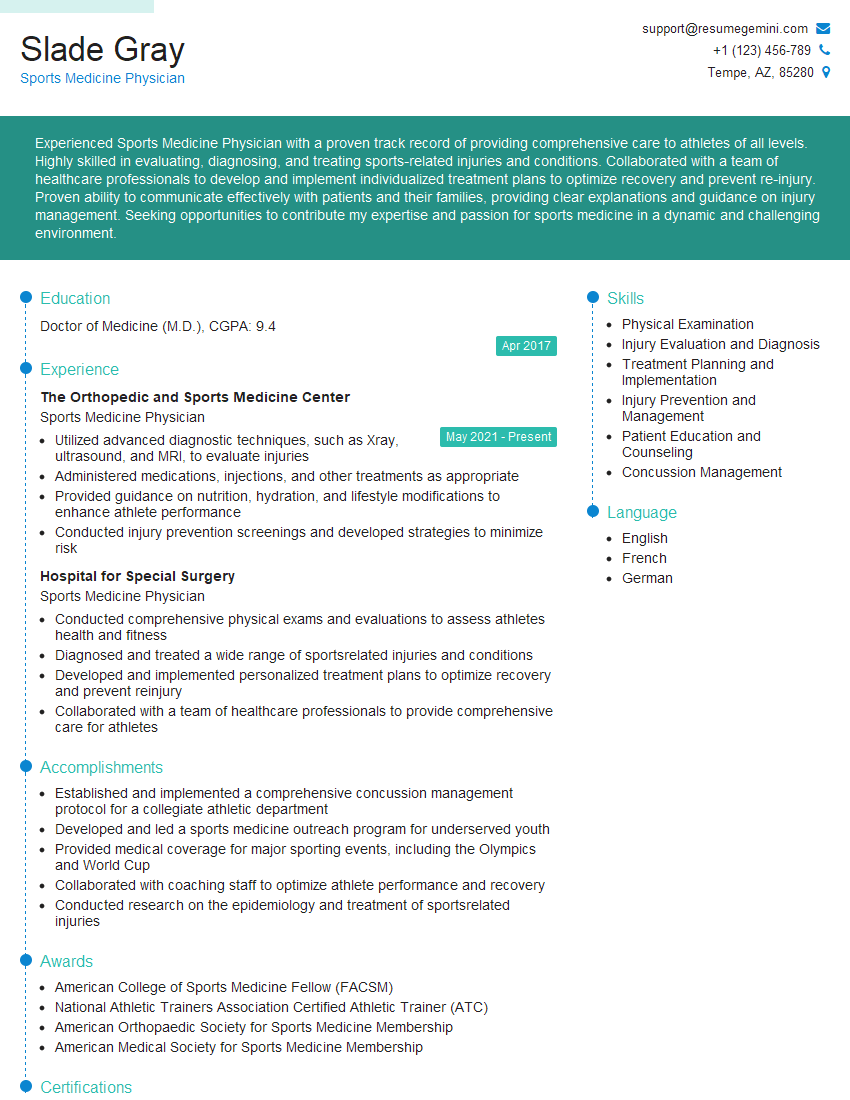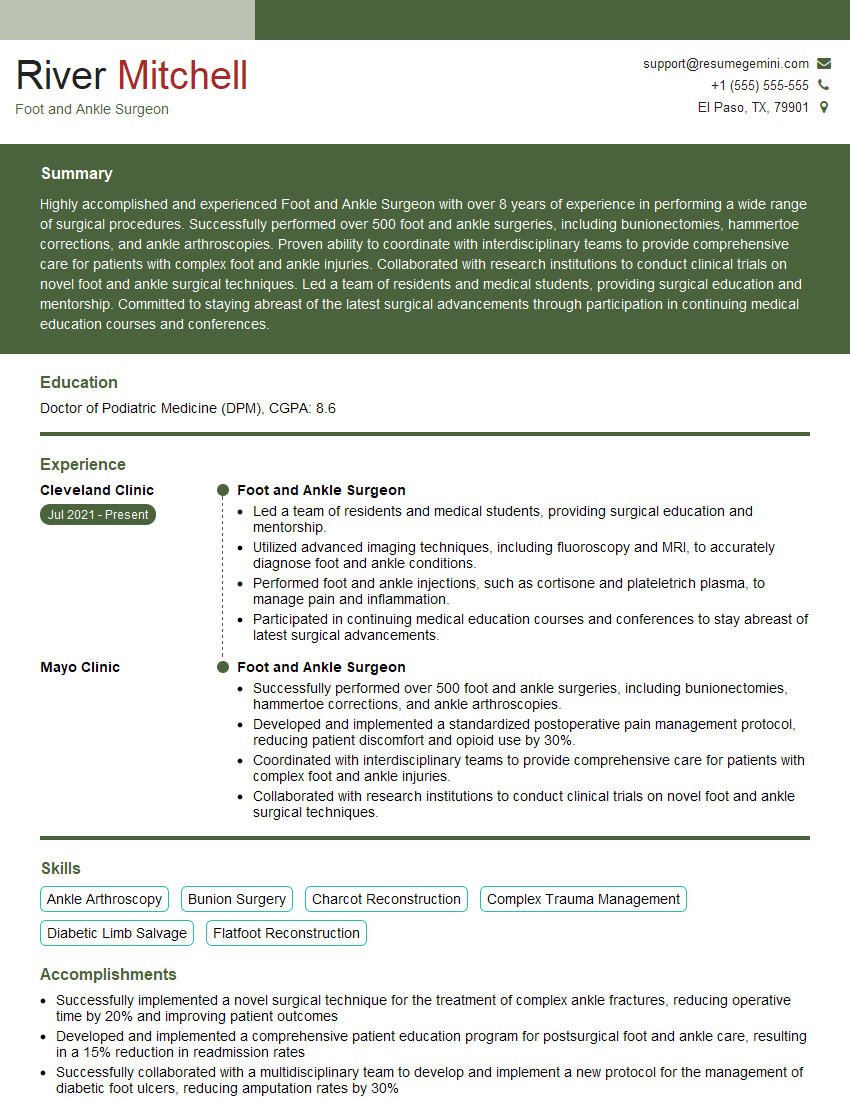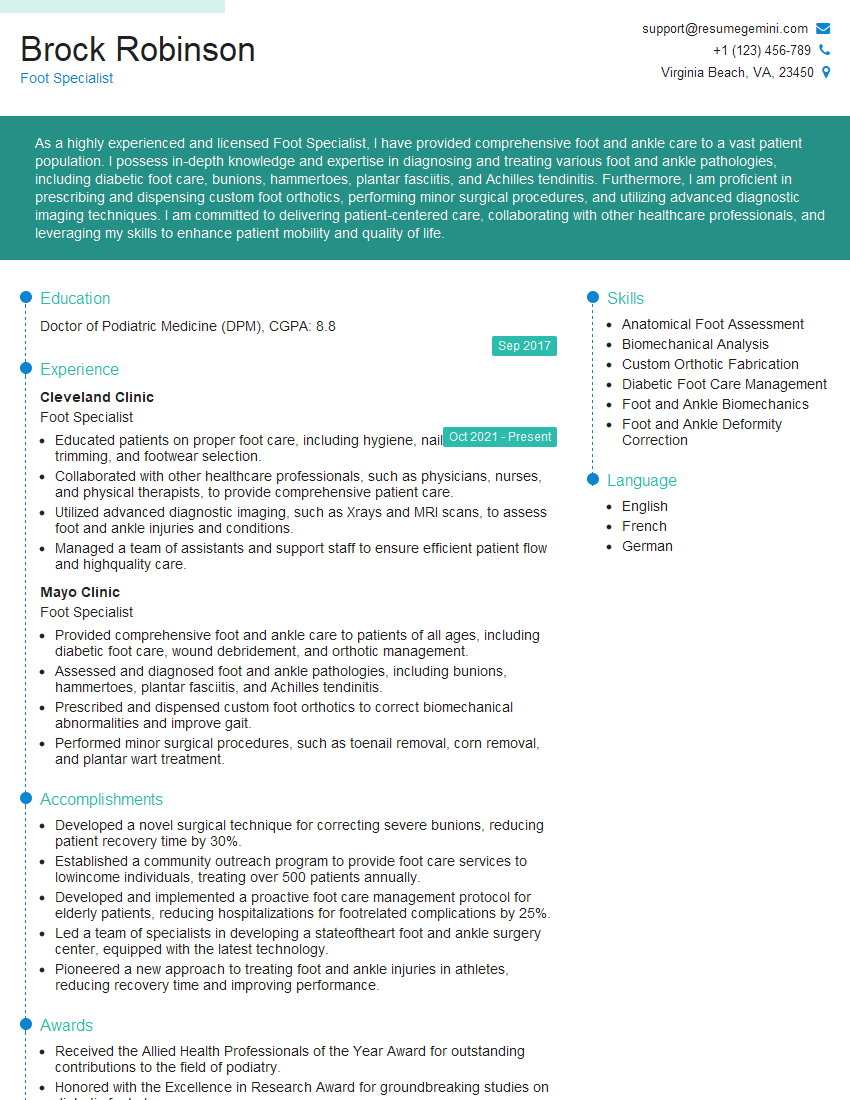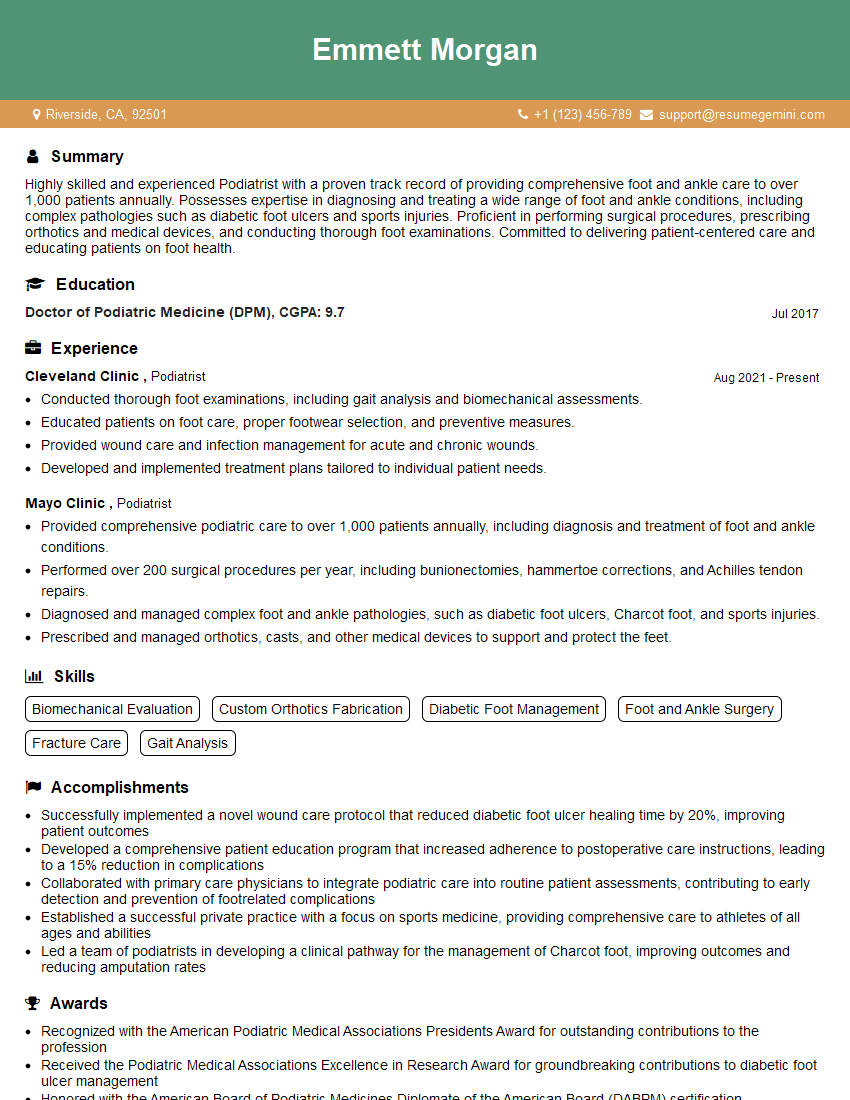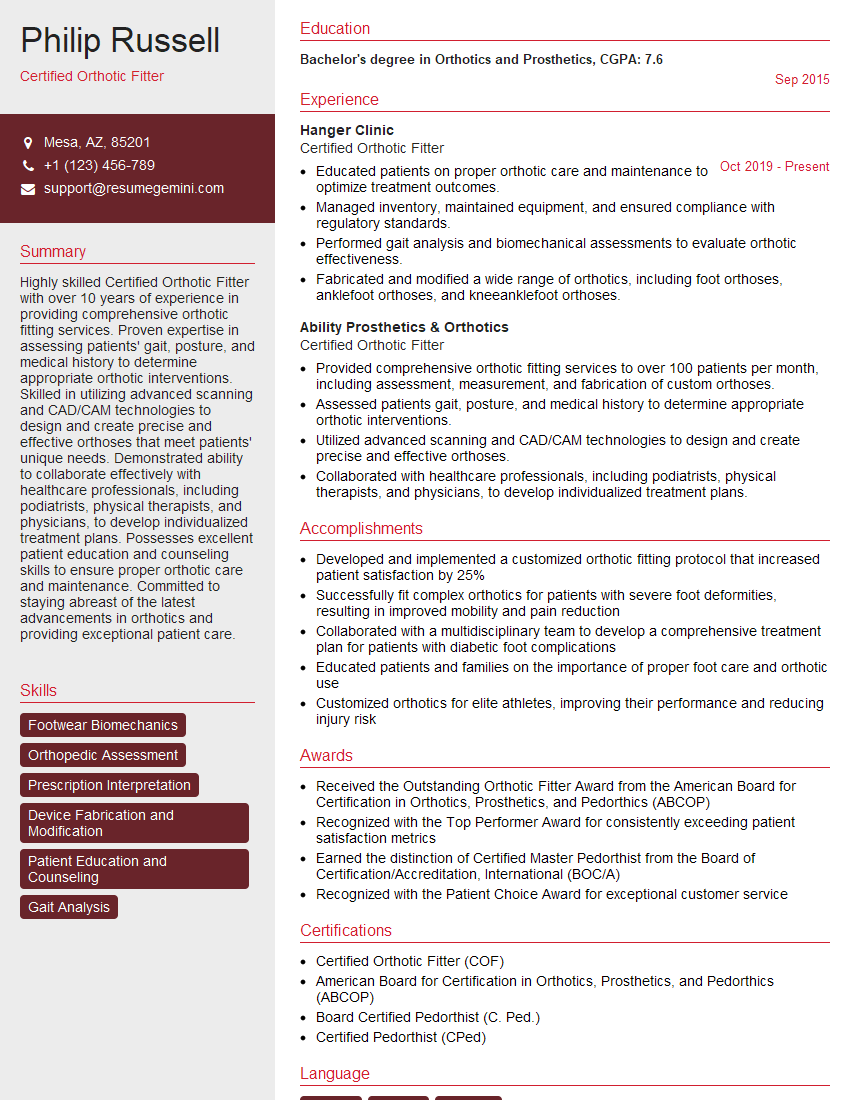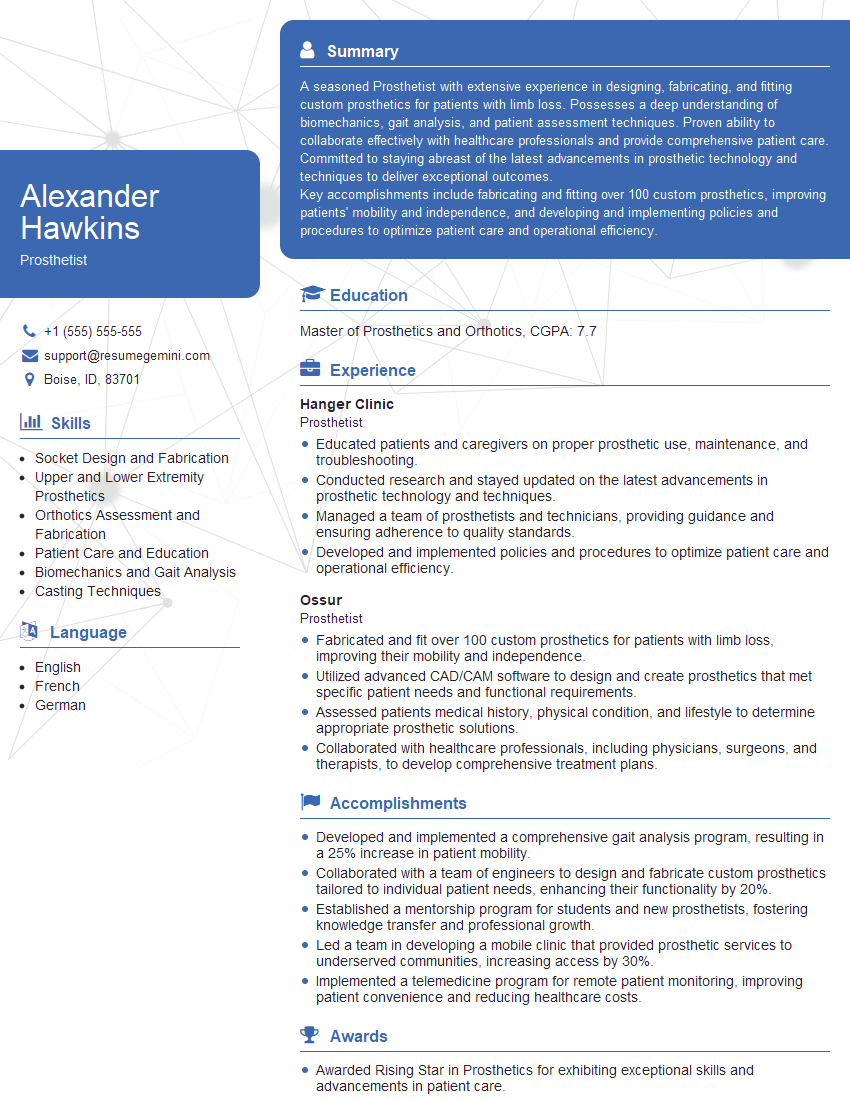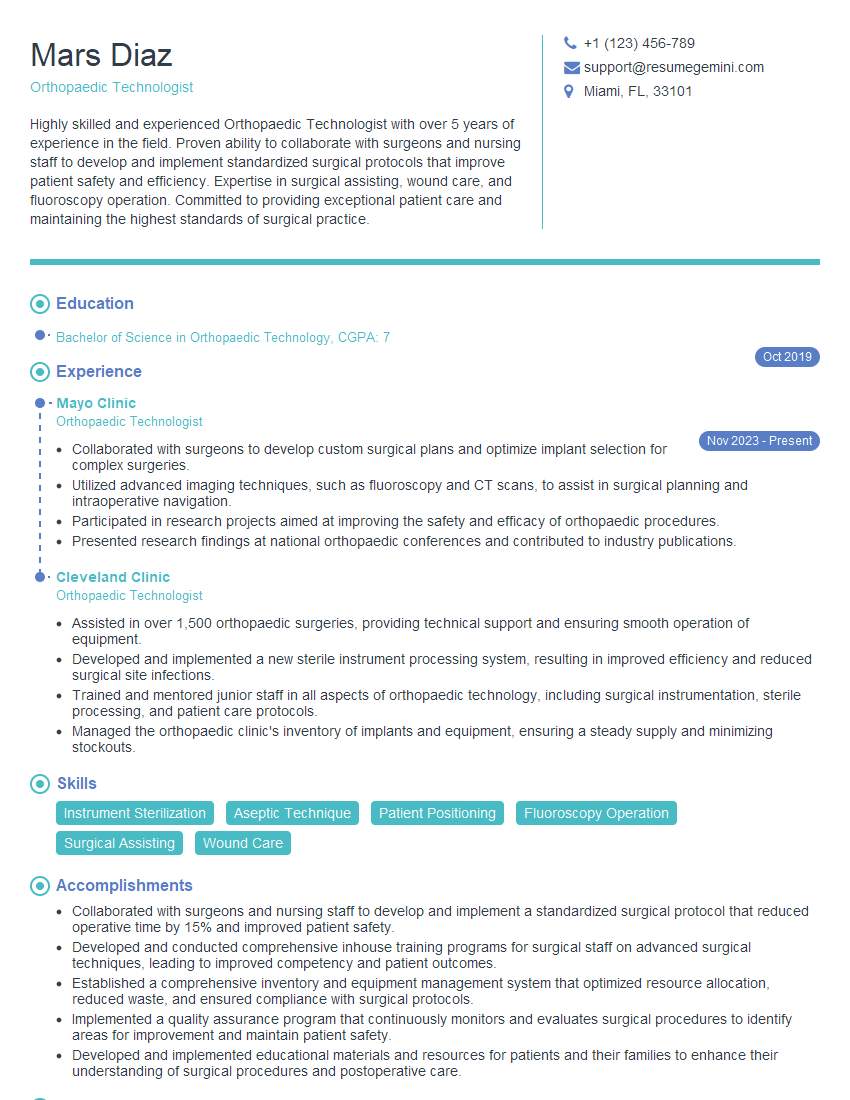Preparation is the key to success in any interview. In this post, we’ll explore crucial Flatfoot Correction interview questions and equip you with strategies to craft impactful answers. Whether you’re a beginner or a pro, these tips will elevate your preparation.
Questions Asked in Flatfoot Correction Interview
Q 1. Explain the different types of flatfoot deformities.
Flatfoot deformities are categorized based on flexibility and the underlying cause. Flexible flatfoot is the most common type, where the arch collapses when weight-bearing but reappears when the foot is not bearing weight. This is often due to weak intrinsic foot muscles or lax ligaments. Rigid flatfoot, on the other hand, shows a collapsed arch regardless of weight-bearing status. This usually indicates a structural problem, often involving bony abnormalities or fusion of tarsal bones. Congenital vertical talus is a severe, rigid flatfoot deformity present at birth, characterized by a severely dorsiflexed talus bone. Adult-acquired flatfoot is a progressive collapse of the medial longitudinal arch in adulthood, often caused by posterior tibial tendon dysfunction (PTTD). Finally, Neuropathic flatfoot occurs in individuals with neurological conditions like Charcot-Marie-Tooth disease, leading to muscle weakness and arch collapse.
- Flexible Flatfoot: Imagine a soft, pliable rope – the arch loses its shape under pressure but returns when the pressure is removed.
- Rigid Flatfoot: Think of a rigid wire – the shape remains unchanged, regardless of pressure.
Q 2. Describe the clinical presentation of adult-acquired flatfoot.
Adult-acquired flatfoot, frequently caused by PTTD, presents with a gradually worsening flatfoot deformity. Patients often describe pain and swelling along the inner aspect of their ankle and foot. They might experience foot fatigue, difficulty walking, and a noticeable flattening of the arch. As the condition progresses, they might develop hindfoot valgus (outward turning of the heel), forefoot abduction (spreading of the toes), and significant pain. Often, they’ll present with a noticeable ‘too many toes’ sign, where they can see more of the medial aspect of their foot.
Clinically, we’ll assess for tenderness along the posterior tibial tendon, assess range of motion of the ankle and subtalar joint, and evaluate the presence of hindfoot valgus and forefoot abduction. A thorough neurological examination is also crucial to rule out other causes of weakness.
Q 3. What are the conservative treatment options for flexible flatfoot in children?
Conservative management of flexible flatfoot in children often focuses on supportive measures and observation. Many children with flexible flatfoot will outgrow the condition. However, if symptoms are significant or the deformity is progressive, interventions may include:
- Observation: Regular monitoring of the foot’s development.
- Orthotics: Custom-made or prefabricated arch supports to support the medial longitudinal arch and prevent further collapse. These are often the first line of treatment.
- Physical therapy: Exercises to strengthen the intrinsic foot muscles and improve flexibility. This can help improve arch support and function.
- Bracing: In some cases, a brace may be necessary to provide additional support and prevent further deformity. This is less common.
- Activity modification: Limiting activities that put excessive stress on the foot, such as prolonged standing or running.
The key here is early intervention and a conservative approach. Surgery is rarely indicated in children with flexible flatfoot.
Q 4. Discuss surgical interventions for rigid flatfoot.
Surgical intervention for rigid flatfoot is complex and tailored to the specific cause and severity of the deformity. It aims to restore the medial longitudinal arch and improve foot function. Procedures can range from simple procedures to very complex multi-stage operations. Some common surgical options include:
- Subtalar arthrodesis: Fusion of the subtalar joint to correct the hindfoot valgus.
- Triple arthrodesis: Fusion of the subtalar, talonavicular, and calcaneocuboid joints for more severe deformities.
- Osteotomies: Bone cuts to realign the bones in the foot and improve arch alignment.
- Posterior tibial tendon reconstruction or transfer: If PTTD is the cause, surgical repair or rerouting of the tendon might be necessary.
- Soft tissue procedures: Release of tight ligaments or tendons to improve flexibility.
The choice of surgery depends on factors like the patient’s age, the severity of the deformity, the presence of arthritis, and overall health. Post-operative care involves immobilization, physical therapy, and gradual weight-bearing to allow for bone healing and recovery.
Q 5. Explain the role of custom orthotics in flatfoot correction.
Custom orthotics play a crucial role in flatfoot correction, especially for flexible flatfoot. These individually designed inserts provide targeted support to the foot’s arches and help reduce pain and improve function. They work by:
- Supporting the medial longitudinal arch: This helps to alleviate strain on the supporting ligaments and muscles.
- Improving foot mechanics: They promote a more normal foot alignment and gait pattern.
- Reducing stress on joints: The cushioning effect can reduce pressure and impact on the ankle, knee, and hip joints.
- Reducing pain: By providing support and cushioning, they can lessen foot pain and discomfort.
Custom orthotics are meticulously designed based on the individual’s foot shape and biomechanics, ensuring optimal fit and effectiveness. They are particularly beneficial for patients with flexible flatfoot who do not require surgical intervention, providing long-term support and pain relief.
Q 6. How do you assess the severity of flatfoot?
Assessing the severity of flatfoot involves a combination of clinical examination and imaging studies. The clinical assessment includes:
- Visual inspection: Evaluating the arch height, presence of hindfoot valgus, and forefoot abduction.
- Palpation: Assessing for tenderness in the posterior tibial tendon and other structures.
- Range of motion assessment: Examining the ankle and subtalar joint flexibility.
- Foot posture index (FPI): This is a validated scoring system that helps quantify foot posture and arch height.
- Weight-bearing assessment: Observing gait patterns and identifying any compensatory movements.
The severity is graded based on these findings, ranging from mild, flexible flatfeet with minimal symptoms to severe, rigid flatfeet with significant structural changes and functional limitations. Imaging helps confirm the diagnosis and the extent of bone deformities if present.
Q 7. What imaging modalities are used to diagnose flatfoot?
Several imaging modalities are used to diagnose and assess flatfoot, depending on the clinical suspicion and the need for detailed information.
- X-rays: These are often the first-line imaging modality. They provide information about the bony structures of the foot and ankle, helping to identify the presence of bone deformities, arthritis, and the extent of the arch collapse. Weight-bearing X-rays are particularly useful in visualizing the alignment and stability of the foot.
- CT scans: These provide high-resolution images of bones and are particularly helpful in evaluating complex deformities and planning surgical interventions. They can reveal subtle bony abnormalities that may not be visible on plain X-rays.
- MRI scans: These are mainly used to assess soft tissues, such as the ligaments and tendons. They are particularly useful for evaluating the integrity of the posterior tibial tendon and other soft tissues surrounding the foot, which might be indicative of underlying causes.
The choice of imaging modality is determined by the specific clinical question and the information required to guide management decisions. Usually, a combination of clinical examination and X-rays suffices for most cases, while other modalities are used on a case-by-case basis.
Q 8. What are the potential complications of flatfoot surgery?
Flatfoot surgery, while often effective, carries potential complications. These can range from minor to severe and are dependent on the individual, the surgical technique employed, and post-operative care. Common complications include:
- Infection: As with any surgery, infection at the surgical site is a risk. This requires prompt medical attention with antibiotics and potentially further surgery.
- Nerve damage: The foot contains numerous nerves, and there’s a risk of injury during the procedure, leading to numbness, tingling, or pain.
- Nonunion: This refers to the failure of bones to heal properly after surgery. It requires additional intervention, often another surgery.
- Hardware problems: If screws, plates, or other implants are used, they may loosen, break, or cause irritation, potentially requiring removal.
- Recurrence of flatfoot: While rare with proper technique and patient compliance, the flatfoot deformity can sometimes recur.
- Stiffness or limited range of motion: Post-operative stiffness is common, but prolonged stiffness can restrict mobility and require physical therapy.
- Chronic pain: Although surgery aims to alleviate pain, some patients may experience persistent pain, sometimes requiring additional management strategies.
- Deep vein thrombosis (DVT): Blood clots in the deep veins of the leg are a potential risk after any surgery, especially in the lower extremities.
It’s crucial to discuss these potential risks with your surgeon before undergoing any procedure to make an informed decision.
Q 9. Describe your experience with different surgical techniques for flatfoot.
My experience encompasses a wide range of surgical techniques for flatfoot correction. The choice of technique depends on factors such as the patient’s age, the severity of the deformity, the presence of associated conditions like arthritis, and their activity level. I routinely utilize several approaches:
- Lateral Column Lengthening: This involves lengthening the outside bone of the midfoot to correct the collapse. I have seen excellent results in patients with flexible flatfoot, especially younger individuals.
- Subtalar Arthrodesis (Fusion): This technique fuses the bones in the subtalar joint, providing stability. It’s usually reserved for patients with more severe, rigid flatfoot, often those with significant arthritis or failed previous surgeries. It achieves excellent pain relief but reduces flexibility.
- Calcaneal Osteotomy: This procedure involves reshaping the heel bone to improve alignment and support. I use this technique in specific cases to address certain components of the deformity.
- Combined procedures: In complex cases, I may combine several of these techniques to achieve optimal correction. For instance, a lateral column lengthening may be combined with a calcaneal osteotomy for a more comprehensive correction.
My approach is highly individualized. I carefully analyze each patient’s specific anatomy and biomechanics to select the most suitable surgical technique for achieving long-term, functional outcomes.
Q 10. How do you differentiate between flexible and rigid flatfoot?
Differentiating between flexible and rigid flatfoot is crucial for choosing the appropriate treatment strategy. The key lies in the arch’s behavior:
- Flexible flatfoot: The arch collapses when weight-bearing but returns to a more normal shape when the foot is not bearing weight. This is often caused by weakened ligaments or tendons. These cases are often successfully treated conservatively with physical therapy, orthotics, or sometimes minimally invasive procedures.
- Rigid flatfoot: The arch remains collapsed even when the foot is not weight-bearing. This usually indicates underlying structural problems, such as bony deformities or arthritis. These cases often require surgical intervention for correction.
A physical exam, including assessment of arch flexibility, and imaging studies like X-rays are used to make the diagnosis.
Imagine a child’s building block structure. A flexible flatfoot is like a slightly wobbly tower that can be made stable again with support. A rigid flatfoot is like a tower with broken blocks, requiring more significant reconstruction.
Q 11. What are the long-term outcomes of flatfoot correction?
Long-term outcomes of flatfoot correction surgery vary depending on several factors, including the patient’s age, the severity of the initial deformity, the surgical technique used, and adherence to post-operative rehabilitation. Generally, patients can expect:
- Pain reduction: A significant reduction in foot and ankle pain is the primary goal. The degree of pain relief varies from patient to patient.
- Improved function: Many patients experience improved walking, running, and overall mobility after surgery.
- Improved arch height: The surgery aims to restore a more normal arch height, although the exact degree of improvement depends on the case.
- Improved alignment: Correction of the foot and ankle alignment can alleviate associated problems such as knee or hip pain.
However, it’s important to note that not everyone achieves a perfect result. Some patients may experience residual pain or stiffness. Regular follow-up visits and adherence to the post-operative rehabilitation program are essential for achieving optimal long-term outcomes.
Q 12. How do you manage post-operative pain and swelling after flatfoot surgery?
Post-operative pain and swelling are common after flatfoot surgery. Management involves a multi-pronged approach:
- Pain management: This typically involves a combination of prescription pain medications (often opioids in the initial days, transitioning to less potent analgesics), and non-steroidal anti-inflammatory drugs (NSAIDs). Occasionally, nerve blocks are used for particularly severe pain.
- Elevation: Keeping the foot elevated helps to reduce swelling. This should be done as much as possible during the early stages of recovery.
- Ice: Applying ice packs to the affected area helps to reduce inflammation and pain. Ice should be applied for 15-20 minutes at a time, several times a day.
- Compression: Wearing a compression bandage or stocking helps to control swelling.
- Physical therapy: A comprehensive physical therapy program is crucial. This involves exercises to improve range of motion, strength, and flexibility.
- Range of Motion Exercises: Specific exercises to improve ankle and foot mobility need to be started early after surgery, and tailored to individual patient recovery progress.
Careful monitoring and adjustment of the pain management strategy are essential. The patient’s comfort level and progress in rehabilitation guide our treatment decisions.
Q 13. What are the common causes of flatfoot in adults?
In adults, flatfoot can develop due to various factors, often involving a combination of issues:
- Posterior Tibial Tendon Dysfunction (PTTD): This is a common cause, where the tendon that supports the arch weakens or tears, leading to arch collapse. It often develops gradually.
- Arthritis: Conditions like rheumatoid arthritis or osteoarthritis can damage the joints in the foot, affecting the arch’s structure and causing collapse.
- Injury: A significant ankle sprain or fracture can disrupt the supporting structures of the arch.
- Excessive pronation: This is a condition where the foot rolls inward excessively during weight-bearing, putting stress on the supporting structures of the arch.
- Congenital conditions: While more common in children, some congenital conditions can manifest or worsen in adulthood, contributing to flatfoot.
- Neuromuscular diseases: Certain neuromuscular disorders can weaken the muscles supporting the arch, leading to flatfoot development.
Identifying the underlying cause is crucial for effective management. Thorough evaluation is necessary to tailor the best intervention strategy.
Q 14. Discuss the role of physical therapy in flatfoot management.
Physical therapy plays a vital role in both conservative management and post-operative rehabilitation of flatfoot. Its importance is multifaceted:
- Conservative management: For individuals with flexible flatfoot and mild symptoms, physical therapy can often prevent or delay surgery. Therapists use exercises to strengthen the muscles supporting the arch, improve flexibility, and teach proper gait mechanics.
- Post-operative rehabilitation: After surgery, physical therapy is crucial for restoring function, improving range of motion, reducing swelling, managing pain, and preventing complications. It focuses on graduated exercises to strengthen weakened muscles and improve joint mobility.
- Orthotic prescription and fitting: Physical therapists often work with patients to select and fit appropriate orthotics (custom shoe inserts) to support the arch and improve foot mechanics.
- Patient education: Therapists educate patients on proper footwear, activities to avoid, and self-management techniques to reduce pain and improve long-term outcomes.
A well-structured and tailored physical therapy program is a cornerstone of successful flatfoot management, promoting both pain relief and functional recovery. Regular follow-ups with a physical therapist after surgery are also recommended to ensure the patient is progressing as expected.
Q 15. How do you counsel patients about the risks and benefits of flatfoot surgery?
Counseling patients about flatfoot surgery requires a balanced approach, carefully weighing the potential benefits against the inherent risks. I begin by explaining that surgery is generally considered only after conservative treatments like orthotics and physical therapy have been exhausted and symptoms persist.
Benefits I discuss potential improvements like reduced pain, improved function, better foot alignment, and increased mobility. I often use patient testimonials or show before-and-after photos (with patient consent) to illustrate these improvements. For example, I might show a patient who experienced significant pain relief and improved ability to walk longer distances after surgery.
Risks I thoroughly explain the potential risks, including infection, nerve damage, stiffness, non-union (the bone not healing properly), implant failure (if applicable), and the possibility that the surgery may not completely resolve the symptoms. The recovery process, which can involve significant discomfort, time off work, and physical therapy, is also discussed transparently. I make sure patients understand that the surgery might not be perfect, and we aim for significant improvement, not necessarily a complete cure. I might describe instances where post-operative pain management required more time and effort than anticipated.
Ultimately, the decision rests with the patient. My role is to provide them with all the necessary information to make an informed choice that aligns with their goals and expectations.
Career Expert Tips:
- Ace those interviews! Prepare effectively by reviewing the Top 50 Most Common Interview Questions on ResumeGemini.
- Navigate your job search with confidence! Explore a wide range of Career Tips on ResumeGemini. Learn about common challenges and recommendations to overcome them.
- Craft the perfect resume! Master the Art of Resume Writing with ResumeGemini’s guide. Showcase your unique qualifications and achievements effectively.
- Don’t miss out on holiday savings! Build your dream resume with ResumeGemini’s ATS optimized templates.
Q 16. What are the indications for surgical intervention in flatfoot?
Surgical intervention for flatfoot is indicated when conservative management (orthotics, physical therapy, medication) has failed to provide adequate pain relief and functional improvement. Specific indications include:
- Severe pain that significantly impacts daily activities and quality of life.
- Significant functional limitations, such as difficulty walking, standing, or participating in recreational activities.
- Progressive deformity where the flatfoot is worsening and causing additional problems, such as ankle instability or arthritis.
- Failed conservative treatment, where a trial of appropriate non-surgical methods for at least 6-12 months hasn’t produced satisfactory results.
- Significant hindfoot valgus (deformity of the back of the foot leading to the flatfoot).
- Rigid flatfoot that doesn’t correct easily even with manipulation.
The decision to proceed with surgery is made on a case-by-case basis after a thorough evaluation of the patient’s condition, considering their age, activity level, and overall health.
Q 17. Describe your experience with different types of custom orthotics.
My experience with custom orthotics spans various designs tailored to individual patient needs. I regularly utilize both accommodative and functional orthotics.
Accommodative orthotics are designed primarily to support the foot’s existing structure, providing cushioning and reducing stress on painful areas. These are often beneficial for patients with less severe flatfoot or those who are not candidates for more aggressive treatment. I have found these particularly helpful for managing pain in patients with plantar fasciitis associated with flat feet.
Functional orthotics aim to correct the underlying biomechanical issues causing the flatfoot. These often involve more complex designs with features designed to realign the foot and ankle, promoting better weight distribution. I’ve used these extensively with patients exhibiting flexible flat feet and associated conditions like posterior tibial tendon dysfunction. These often include medial posting, which elevates the arch and supports the collapse.
The materials used vary, from soft foam to more rigid materials like carbon fiber or graphite, depending on the patient’s specific needs and the degree of support required. I collaborate closely with certified pedorthists to ensure the orthotics are precisely fabricated and fitted for each patient, often making adjustments based on patient feedback and clinical assessment.
Q 18. How do you select the appropriate treatment plan for a patient with flatfoot?
Selecting the appropriate treatment plan for flatfoot involves a comprehensive approach incorporating several key steps:
- Thorough history and physical examination: This includes evaluating the patient’s symptoms, the degree of flatfoot deformity, their activity level, medical history, and expectations. I assess flexibility, range of motion, and the presence of any associated conditions.
- Imaging studies: X-rays are crucial for assessing the severity of the deformity, the presence of arthritis, and other structural abnormalities. Sometimes, MRI or CT scans are needed for a more detailed assessment, especially when assessing the posterior tibial tendon.
- Conservative management trial: Initially, I generally recommend conservative treatment using orthotics, physical therapy (focused on strengthening the supporting muscles and improving flexibility), and non-steroidal anti-inflammatory drugs (NSAIDs). I closely monitor the patient’s progress, adjusting the treatment plan as needed.
- Assessment of response to conservative management: If conservative management fails to provide sufficient pain relief and functional improvement after a reasonable trial period (6-12 months), then surgery becomes a viable option.
- Surgical planning (if necessary): If surgery is considered, I discuss the various surgical options available, including the potential risks and benefits, and select the procedure best suited to the individual patient’s condition.
The entire process is iterative and collaborative. Patient involvement in decision-making is crucial to ensure that the chosen treatment aligns with their individual needs and goals.
Q 19. What are the contraindications for flatfoot surgery?
Contraindications for flatfoot surgery are generally related to factors that increase the risk of complications or reduce the likelihood of a successful outcome. These include:
- Severe peripheral vascular disease: Poor blood supply to the foot can compromise healing.
- Uncontrolled diabetes: This increases the risk of infection and delayed wound healing.
- Significant medical comorbidities: Conditions such as severe heart or lung disease might make surgery too risky.
- Unrealistic patient expectations: Patients must understand that surgery may not completely eliminate all symptoms and that a period of rehabilitation is required.
- Lack of patient compliance: Surgery requires significant post-operative participation, and lack of adherence to the treatment plan can lead to poor results.
- Active infection: Any active infection in the body can increase the risk of post-operative infection.
A careful evaluation of these factors is essential before proceeding with surgery. In some cases, alternative treatments, such as modified activities or assistive devices, may be more appropriate.
Q 20. How do you assess patient satisfaction after flatfoot correction?
Assessing patient satisfaction after flatfoot correction involves a multi-faceted approach that extends beyond simply asking whether they feel better. I employ a combination of methods to obtain a holistic understanding of their experience.
- Quantitative measures: I use validated questionnaires like the Foot and Ankle Outcome Score (FAOS) and the American Orthopaedic Foot and Ankle Society (AOFAS) ankle-hindfoot scale to objectively measure improvements in pain, function, and quality of life. Numerical scores provide quantifiable data to track progress.
- Qualitative measures: I conduct detailed follow-up interviews to gather rich, descriptive information about the patient’s experience, addressing their satisfaction with the surgical outcome, the recovery process, and the impact on their daily lives. This allows me to gain a more nuanced understanding of their overall well-being beyond numerical scores.
- Physical examination: Regular physical examinations allow me to assess the healing process, evaluate range of motion, strength, and stability. Comparing pre-operative and post-operative findings provides objective clinical evidence of the effectiveness of the surgery.
- Long-term follow-up: I maintain regular contact with patients for at least a year or more after surgery to monitor their progress and address any lingering concerns.
By combining quantitative and qualitative data, I can build a comprehensive picture of patient satisfaction and identify areas for potential improvement in my practice.
Q 21. Describe your experience with non-surgical management of flatfoot.
Non-surgical management of flatfoot plays a crucial role in the treatment of this condition, often being the first line of defense. My approach involves a combination of therapies aimed at alleviating pain, improving function, and slowing disease progression.
- Orthotics: Custom-made orthotics are frequently prescribed to support the arch, improve foot alignment, and reduce stress on painful structures. The type of orthotic is selected based on the severity of the flatfoot and the underlying biomechanical factors.
- Physical therapy: A tailored exercise program helps strengthen the muscles supporting the foot and ankle, improving flexibility, stability, and proprioception (awareness of joint position). Specific exercises focus on strengthening the tibialis posterior muscle, which plays a crucial role in supporting the arch. I often guide patients through exercises, providing demonstrations and guidance.
- Medication: Non-steroidal anti-inflammatory drugs (NSAIDs) can help manage pain and inflammation. I always carefully discuss potential side effects and alternative pain management strategies.
- Weight management: For overweight or obese individuals, weight loss can significantly reduce stress on the foot and ankle. I often collaborate with dietitians or other health professionals to support this goal.
- Activity modification: Adjustments to physical activities, such as reducing high-impact exercises or using supportive footwear, can help alleviate stress and pain.
The effectiveness of non-surgical management varies depending on the individual and the severity of the condition. However, it often provides significant relief for many patients and can delay or even prevent the need for surgery.
Q 22. What are the common complications associated with custom orthotics?
While custom orthotics are generally well-tolerated and effective for many individuals with flat feet, some complications can arise. These are thankfully uncommon with proper fitting and patient education.
- Skin irritation: Friction from the orthotic material can cause redness, blisters, or even sores. This is often addressed by adjusting the orthotic, using appropriate cushioning, or changing sock materials. We often recommend starting with shorter wear times and gradually increasing duration.
- Calluses and corns: Pressure points from the orthotic can lead to thickened skin. Regular foot checks and potential adjustments are crucial to prevent this.
- Pain: Initially, some patients might experience increased pain as their feet adapt to the orthotics. This is usually temporary and managed with pain medication and gradual orthotic use.
- Muscle soreness: The orthotics may change muscle activation patterns, resulting in temporary muscle soreness. This is often resolved with regular exercise and stretching.
- Allergic reactions: In rare cases, individuals may be allergic to the materials used in the orthotics. We carefully select materials considering potential allergies.
It’s crucial to emphasize proactive communication with the patient. Regular follow-up appointments are vital to monitor for and address any complications.
Q 23. How do you address patient concerns and expectations regarding flatfoot treatment?
Managing patient expectations is paramount in flatfoot treatment. I begin by actively listening to their concerns, understanding their goals, and explaining the condition clearly using simple, non-technical language. Realistic expectations are key.
For example, I might explain that while surgery might offer significant correction, it’s not a guarantee of complete pain relief, and recovery involves a significant commitment to physical therapy. Similarly, conservative treatments like orthotics may improve symptoms but may not fully correct the anatomical deformity.
I use visual aids like anatomical models and X-rays to demonstrate the condition and the proposed treatment’s effects. I present different treatment options, outlining their benefits, risks, and limitations. Open communication throughout the process ensures shared decision-making and increases patient compliance.
I always include the possibility that the desired outcome may not be fully achieved. This transparency helps avoid disappointment and fosters a strong doctor-patient relationship.
Q 24. What are the latest advancements in flatfoot correction?
Recent advancements in flatfoot correction are continuously refining treatment strategies. Minimally invasive surgical techniques are becoming more prevalent, leading to faster recovery times and reduced scarring. Computer-assisted surgery allows for greater precision during procedures.
Advancements in orthotic design include the use of new, lightweight materials and improved biomechanical designs that enhance support and comfort. The integration of sensors and data analytics in custom orthotics provides detailed information on patient gait and foot mechanics, allowing for personalized adjustments and improved outcomes.
Furthermore, research into regenerative medicine, such as stem cell therapy, shows promise in improving tissue repair and potentially reducing the need for surgery in some cases. This is an exciting area, although more research is needed before widespread clinical implementation.
Q 25. How do you monitor patient progress after flatfoot surgery?
Post-surgical monitoring involves a multi-faceted approach. It begins with regular follow-up appointments to assess wound healing, pain levels, and range of motion. Weight-bearing is gradually increased as healing progresses. Radiographic imaging (X-rays) are used to monitor bone healing and the position of the surgical implants.
Functional assessments, such as gait analysis, help to evaluate the patient’s ability to walk and perform daily activities. Physical therapy plays a vital role, guiding patients through exercises to regain strength, flexibility, and improve functional mobility. Pain management is a key aspect, often requiring a combination of medication, physical modalities, and patient education.
Patient-reported outcome measures (PROMs) are increasingly utilized to assess patient satisfaction and overall quality of life following surgery. These questionnaires provide valuable insights into the patient’s experience and functional improvements.
Q 26. Describe your experience working with a multidisciplinary team in managing flatfoot.
Managing flatfoot effectively necessitates a multidisciplinary approach. I regularly collaborate with podiatrists, orthopedic surgeons, physical therapists, and radiologists. A podiatrist provides expertise on foot biomechanics and conservative treatments like orthotics. Orthopedic surgeons perform surgical interventions when necessary. Physical therapists implement rehabilitation programs, tailored to individual patient needs.
Radiologists provide crucial imaging information to guide diagnosis and treatment planning. This integrated team approach ensures comprehensive patient care. For example, in a complex case, we might have a combined clinic where each specialist examines the patient and contributes their expertise to create a single, collaborative treatment plan.
Effective communication within the team is vital for seamless care transitions and optimal patient outcomes. Regular team meetings and shared patient records help ensure everyone is updated on the patient’s progress and treatment plan.
Q 27. What are your strategies for managing challenging cases of flatfoot?
Challenging cases, such as those with severe deformity, significant pain, or co-morbidities, require a tailored, individualized approach. We meticulously assess the patient’s medical history, conduct thorough physical examinations, and utilize advanced imaging techniques to fully understand the extent of the condition.
A multidisciplinary team meeting is often convened to discuss the case and determine the optimal treatment strategy. Conservative treatments, such as custom orthotics and physical therapy, are always considered first. If conservative measures fail, we explore surgical options, carefully weighing the risks and benefits of each procedure. Minimally invasive surgical techniques are often prioritized to minimize trauma and facilitate faster recovery.
Post-operative management is intensive, involving regular follow-up appointments, close monitoring for complications, and a tailored rehabilitation program. In some cases, we may utilize advanced technologies like computer-assisted surgery or 3D-printed models to optimize surgical planning and outcomes.
Q 28. How do you stay updated on the latest research and advancements in flatfoot correction?
Staying current in the rapidly evolving field of flatfoot correction requires a multi-pronged approach. I regularly attend national and international conferences and workshops on podiatric and orthopedic surgery. Professional memberships in relevant organizations, such as the American Academy of Orthopaedic Surgeons (AAOS) and the American College of Foot and Ankle Surgeons (ACFAS), provide access to the latest research and educational resources.
I dedicate time to reviewing peer-reviewed journals and medical literature. Online resources and databases, such as PubMed and Medline, are invaluable tools for searching and accessing current research findings. Moreover, participation in continuing medical education (CME) courses and workshops keeps me updated on the latest advancements in surgical techniques, orthotic design, and rehabilitation protocols.
Collaborating with colleagues and attending grand rounds at our institution facilitates knowledge exchange and allows me to learn from others’ experience. Continuous learning is vital in this dynamic field to provide the most advanced and effective care to my patients.
Key Topics to Learn for Flatfoot Correction Interview
- Anatomy and Biomechanics of the Foot and Ankle: Understanding the structures involved in flatfoot, including bones, ligaments, muscles, and tendons, and how they function in weight-bearing and movement.
- Types of Flatfoot: Differentiating between flexible and rigid flatfoot, and understanding the causes and clinical presentations of each.
- Diagnosis and Assessment: Familiarize yourself with various diagnostic methods, including physical examination techniques, imaging studies (X-rays, MRI), and gait analysis.
- Conservative Treatment Approaches: Mastering the knowledge of non-surgical interventions such as orthotics, physical therapy, bracing, and medication.
- Surgical Techniques for Flatfoot Correction: Gaining an understanding of different surgical procedures used to correct flatfoot deformities and their indications.
- Post-operative Care and Rehabilitation: Understanding the protocols for post-surgical management, including wound care, pain management, and physical therapy regimens.
- Patient Communication and Education: Developing effective communication skills to explain diagnoses, treatment options, and potential outcomes to patients and their families.
- Complications and Management: Understanding potential complications associated with flatfoot correction and strategies for managing them.
- Current Research and Advances: Staying updated on the latest research and advancements in the field of flatfoot correction.
- Case Studies and Problem Solving: Practice analyzing case studies and applying your knowledge to solve clinical problems related to flatfoot correction.
Next Steps
Mastering Flatfoot Correction demonstrates a deep understanding of musculoskeletal biomechanics and surgical techniques, significantly enhancing your career prospects in orthopedics and podiatry. To maximize your chances of securing your dream role, focus on crafting a compelling and ATS-friendly resume that showcases your skills and experience effectively. ResumeGemini is a trusted resource that can help you build a professional and impactful resume. Utilize its tools and resources to create a resume that highlights your expertise in Flatfoot Correction. Examples of resumes tailored to this field are available to guide you.
Explore more articles
Users Rating of Our Blogs
Share Your Experience
We value your feedback! Please rate our content and share your thoughts (optional).
What Readers Say About Our Blog
This was kind of a unique content I found around the specialized skills. Very helpful questions and good detailed answers.
Very Helpful blog, thank you Interviewgemini team.



